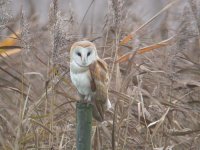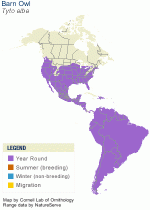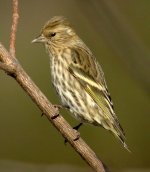weather
Pirate name: Poncy Henry Goodfellow
Barn Owl
Barn Owl
Tyto alba
Order STRIGIFORMES - Family TYTONIDAE
The Barn Owl is one of the most widely distributed birds in the world, found on all continents except Antarctica, and on many oceanic islands as well. It has been introduced by people to some of the few places it did not already occur, namely Hawaii, the Seychelles Islands, and Lord Howe Island.
Cool Facts:
* Watch what happens inside a Barn Owl nest http://www.birds.cornell.edu/birdhouse2/nestboxcam/, through the help of a Nest Box Cam provided by The Birdhouse Network at the Cornell Lab of Ornithology. Currently there are active Barn Owl nests in California and Texas. Go here http://www.birds.cornell.edu/birdhouse/nestboxcam/historical/CAarchive1_2004.html for pictures of the complete nest cycle from a nest in California in 2004.
* The female Barn Owl tends to be more spotted on the breast than the male. These spots may act as a stimulus to the male, indicating the quality of the female. If a female's spots were experimentally removed, her mate fed their nestlings at a lower rate than if the spots were left alone.
* Up to 46 different races of the Barn Owl have been described worldwide. The North American form is the largest, weighing more than twice as much as the smallest race from the Galapagos Islands.
* The Barn Owl is one of the few bird species with the female showier than the male. The female has a more reddish chest that is more heavily spotted. The spots may signal to a potential mate the quality of the female. Heavily spotted females get fewer parasitic flies and may be more resistant to parasites and diseases.
* The Barn Owl has excellent low-light vision, and can easily find prey at night by sight. But its ability to locate prey by sound alone is the best of any animal that has ever been tested. It can catch mice in complete darkness in the lab, or hidden by vegetation or snow out in the real world.
Description:
* Size: 32-40 cm (13-16 in)
* Wingspan: 100-125 cm (39-49 in)
* Weight: 400-700 g (14.12-24.71 ounces)
* Medium-sized owl.
* White or mostly white underside.
* Heart-shaped, white face.
* Back tawny, marked with black and white spots.
* Long legs.
* Eyes dark.
* Round head without ear tufts.
* Rounded wings.
* Tail relatively short.
* Legs and toes light gray.
Sex Differences:
Sexes similar in plumage, but females are larger, darker, and more spotted below.
Immature:
Immature like adult.
Similar Species:
* Snowy Owl is white on the back as well as on the front.
* Short-eared Owl can look nearly white from below, but it has a black crescent in the middle of the wing, and dark wingtips.
* Young Great Horned Owl can be largely pale below, lack ear tufts, and give hoarse rasping calls, but its face is orange.
Sound:
Call is a drawn-out, hissing scream.
Summer Range:
Resident from northern United States and southern British Columbia southward through Central and South America and the Caribbean. Also Africa, Europe, southeast Asia, Australia, and some oceanic islands. Introduced to Hawaii, Seychelles Islands, and Lord Howe Island.
Habitat:
Found in open habitats, such as grasslands, deserts, marshes, and agricultural fields.
Food:
Small mammals.
Behavior:
Foraging
Hunts at night, flying low over ground.
Reproduction:
Nest Type
Nests in hollow trees, cliff cavities, in buildings, and nest boxes. Nest cup made from shredded owl pellets.
Egg Description:
Dull white.
Clutch Size:
Usually 3-9 eggs. Range: 2-18.
Condition at Hatching:
Helpless and covered with white down.
Conservation Status:
Common, but local in some parts of its range. Populations in Midwest and inland East dropped dramatically during 1970-2000. Listed as Endangered in some states. Nest box programs have helped increase populations in some areas.
Other Names:
effraie (French)
Lechuza de campanario (Spanish)
Sources used to construct this page:
1 (A. Poole, P. Stettenheim, and F. Gill, eds.). The Academy of Natural Sciences, Philadelphia, PA, and The American Ornithologists' Union, Washington, D.C.
2. Roulin, A. 1999. Nonrandom pairing by male barn owls (Tyto alba) with respect to a female plumage trait. Behavioral Ecology 10: 688-695.
3. Roulin , A., C. Riols , C. Dijkstra, and A.-L. Ducrest. 2001. Female plumage spottiness signals parasite resistance in the barn owl (Tyto alba). Behavioral Ecology 12: 103-110.
Mike
Photo by BF member Carl Baggott
Barn Owl
Tyto alba
Order STRIGIFORMES - Family TYTONIDAE
The Barn Owl is one of the most widely distributed birds in the world, found on all continents except Antarctica, and on many oceanic islands as well. It has been introduced by people to some of the few places it did not already occur, namely Hawaii, the Seychelles Islands, and Lord Howe Island.
Cool Facts:
* Watch what happens inside a Barn Owl nest http://www.birds.cornell.edu/birdhouse2/nestboxcam/, through the help of a Nest Box Cam provided by The Birdhouse Network at the Cornell Lab of Ornithology. Currently there are active Barn Owl nests in California and Texas. Go here http://www.birds.cornell.edu/birdhouse/nestboxcam/historical/CAarchive1_2004.html for pictures of the complete nest cycle from a nest in California in 2004.
* The female Barn Owl tends to be more spotted on the breast than the male. These spots may act as a stimulus to the male, indicating the quality of the female. If a female's spots were experimentally removed, her mate fed their nestlings at a lower rate than if the spots were left alone.
* Up to 46 different races of the Barn Owl have been described worldwide. The North American form is the largest, weighing more than twice as much as the smallest race from the Galapagos Islands.
* The Barn Owl is one of the few bird species with the female showier than the male. The female has a more reddish chest that is more heavily spotted. The spots may signal to a potential mate the quality of the female. Heavily spotted females get fewer parasitic flies and may be more resistant to parasites and diseases.
* The Barn Owl has excellent low-light vision, and can easily find prey at night by sight. But its ability to locate prey by sound alone is the best of any animal that has ever been tested. It can catch mice in complete darkness in the lab, or hidden by vegetation or snow out in the real world.
Description:
* Size: 32-40 cm (13-16 in)
* Wingspan: 100-125 cm (39-49 in)
* Weight: 400-700 g (14.12-24.71 ounces)
* Medium-sized owl.
* White or mostly white underside.
* Heart-shaped, white face.
* Back tawny, marked with black and white spots.
* Long legs.
* Eyes dark.
* Round head without ear tufts.
* Rounded wings.
* Tail relatively short.
* Legs and toes light gray.
Sex Differences:
Sexes similar in plumage, but females are larger, darker, and more spotted below.
Immature:
Immature like adult.
Similar Species:
* Snowy Owl is white on the back as well as on the front.
* Short-eared Owl can look nearly white from below, but it has a black crescent in the middle of the wing, and dark wingtips.
* Young Great Horned Owl can be largely pale below, lack ear tufts, and give hoarse rasping calls, but its face is orange.
Sound:
Call is a drawn-out, hissing scream.
Summer Range:
Resident from northern United States and southern British Columbia southward through Central and South America and the Caribbean. Also Africa, Europe, southeast Asia, Australia, and some oceanic islands. Introduced to Hawaii, Seychelles Islands, and Lord Howe Island.
Habitat:
Found in open habitats, such as grasslands, deserts, marshes, and agricultural fields.
Food:
Small mammals.
Behavior:
Foraging
Hunts at night, flying low over ground.
Reproduction:
Nest Type
Nests in hollow trees, cliff cavities, in buildings, and nest boxes. Nest cup made from shredded owl pellets.
Egg Description:
Dull white.
Clutch Size:
Usually 3-9 eggs. Range: 2-18.
Condition at Hatching:
Helpless and covered with white down.
Conservation Status:
Common, but local in some parts of its range. Populations in Midwest and inland East dropped dramatically during 1970-2000. Listed as Endangered in some states. Nest box programs have helped increase populations in some areas.
Other Names:
effraie (French)
Lechuza de campanario (Spanish)
Sources used to construct this page:
1 (A. Poole, P. Stettenheim, and F. Gill, eds.). The Academy of Natural Sciences, Philadelphia, PA, and The American Ornithologists' Union, Washington, D.C.
2. Roulin, A. 1999. Nonrandom pairing by male barn owls (Tyto alba) with respect to a female plumage trait. Behavioral Ecology 10: 688-695.
3. Roulin , A., C. Riols , C. Dijkstra, and A.-L. Ducrest. 2001. Female plumage spottiness signals parasite resistance in the barn owl (Tyto alba). Behavioral Ecology 12: 103-110.
Mike
Photo by BF member Carl Baggott






